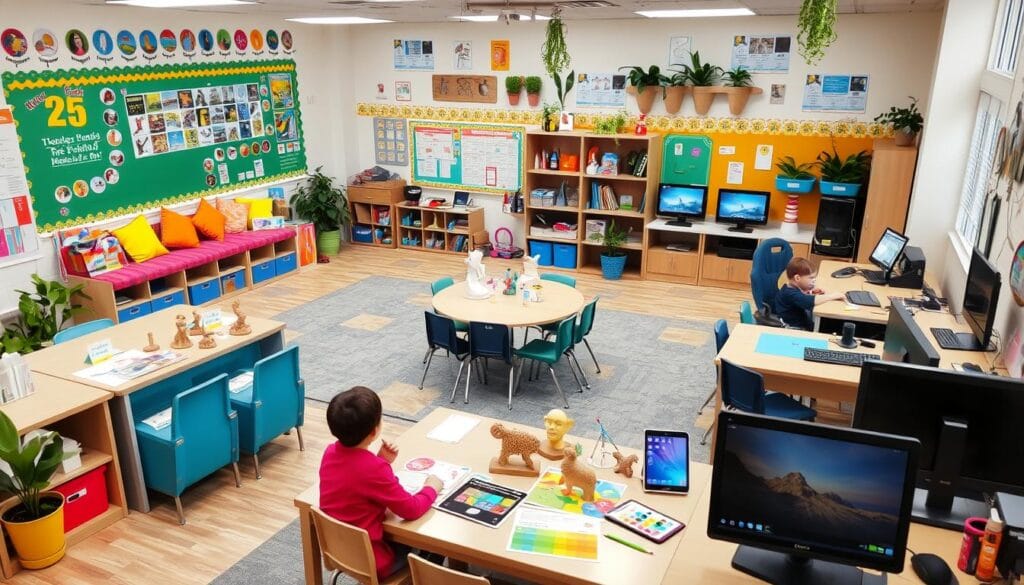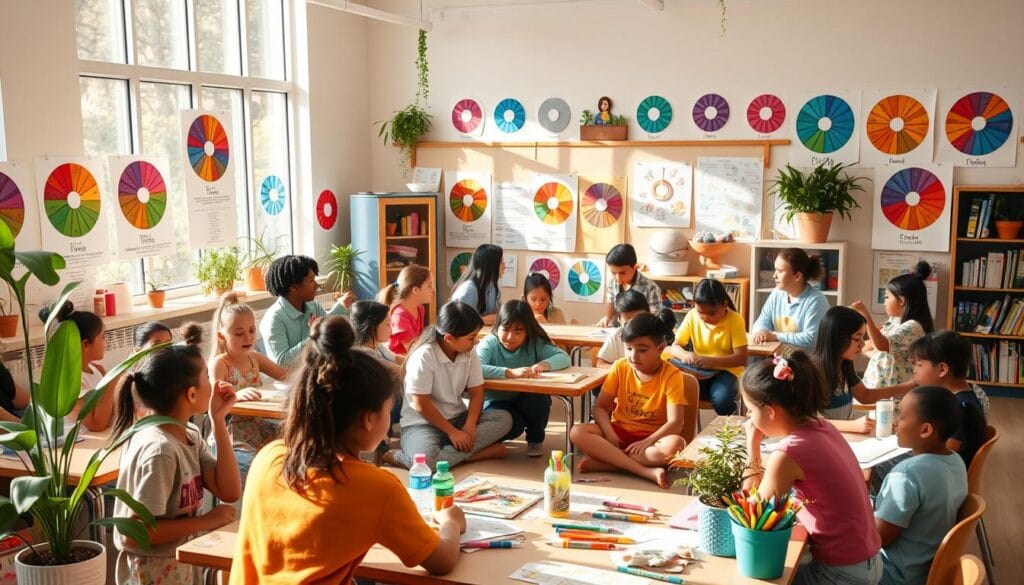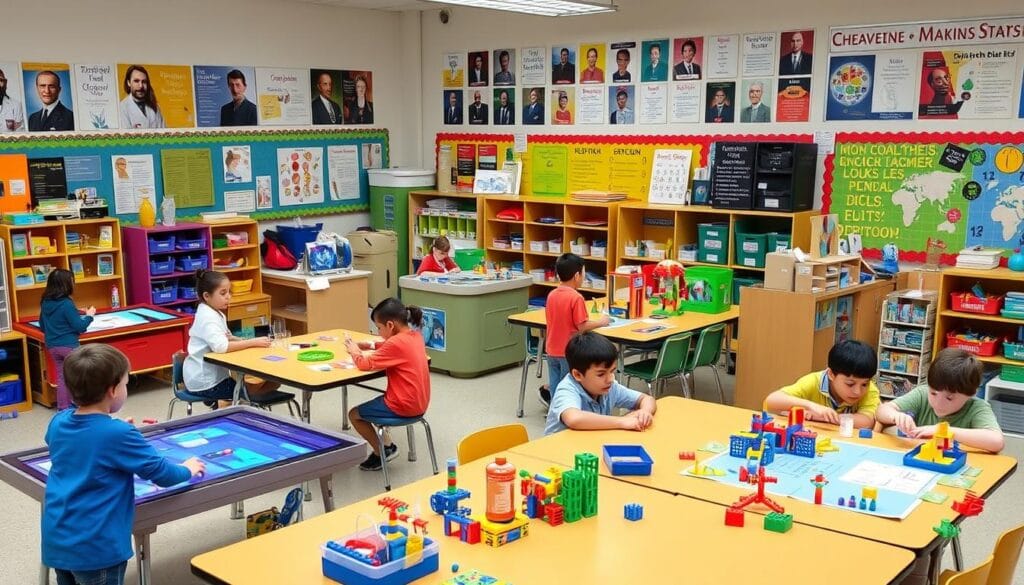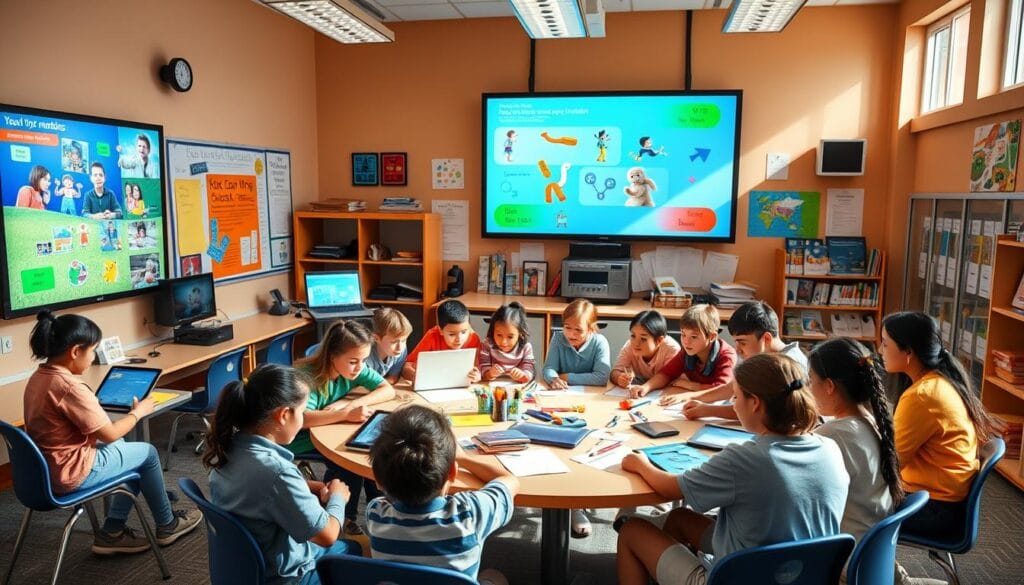Innovative Classroom Learning Centers: Types and Effective Tips
Classroom learning centers are changing how we learn. They make learning fun and interactive. These special areas in the classroom help students explore, work together, and learn new skills.
As a teacher, you can make these learning centers exciting. They spark students’ curiosity and help them understand more about what they’re learning.
By adding different learning centers to your classroom, you meet students’ needs in many ways. This approach makes learning more engaging and fun. It goes beyond just sitting in a classroom listening to a teacher.
There are many types of learning centers, like those focused on reading or science. This guide will show you how to set up these centers. We’ll also give you tips to make them work best for your students.
فهرس المقالة
Understanding the Power of Learning Stations in Modern Education
In today’s education, learning hubs have changed how students learn. These educational centers offer a hands-on way to learn. Students can now take a more active role in their education.
Benefits of Station-Based Learning
Learning stations in classrooms bring many benefits. Students get to move between different stations, learning in new ways. This method helps students learn more on their own and work together better.
Key Components of Successful Learning Hubs
- Clear goals and activities for learning
- Fun, multi-sensory materials and resources
- Flexible seating and workspaces
- Space for students to explore and try new things
- Technology to make learning more engaging
Impact on Student Engagement
Learning hubs have greatly improved how students feel about learning. These educational centers make learning exciting and interactive. Students are more likely to be involved and curious because they can explore and work together.
“The true purpose of education is to develop the powers of observation and judgment, not just to accumulate facts.”
Essential Types of Classroom Learning Centers
Classroom learning centers are key to a lively and engaging learning space. They cover different subjects and learning ways, making education well-rounded for students. Let’s look at some important learning centers you can add to your classroom.
Literacy Centers
Literacy centers help students grow in reading, writing, and language. They have books, word games, and writing stations. These centers help students love reading and get better at talking and writing.
Math Centers
Math centers let students dive into math, solve problems, and get better at numbers. They have puzzles, games, and stations for different math topics. This hands-on learning helps students understand math better.
Science and Exploration Centers
Science centers encourage students to do hands-on science experiments. They have interactive displays and tools for different science areas. This helps students learn by doing and exploring.
Art and Creativity Centers
Art centers help students express themselves and be creative. They have art supplies and stations for painting, drawing, and more. These centers let students show their imagination and creativity.
Adding these learning centers makes your classroom lively and engaging. They meet different learning needs and interests. Make sure these centers fit your curriculum and teaching goals.

“The true sign of intelligence is not knowledge but imagination.” – Albert Einstein
Designing Interactive Literacy Centers That Inspire
In today’s education, making literacy centers fun is key. These centers are lively places where students dive into reading and writing. They get to try out language arts through fun activities and deep experiences.
Reading and Writing Station Elements
A cozy reading nook with comfy chairs and lots of books is great. It makes students want to explore books. A writing station with tools and prompts lets students show their creativity.
Vocabulary Development Activities
Literacy centers are perfect for learning new words. Activities like word walls and games make learning fun. They help students discover the magic of language.
Phonics and Word Work Areas
Phonics and word work areas help students improve reading and spelling. Activities like matching letters and building words make learning fun. These activities are key for reading and writing success.
By creating these centers, teachers inspire a love for learning. Students learn to express themselves through words.
STEM Centers: Fostering Scientific Discovery

STEM centers are key in today’s education. They give students a chance to explore hands-on, deepening their love for science, tech, engineering, and math.
These centers are more than science labs or math stations. They’re places where students think critically, solve problems, and get creative. Interactive activities and experiments spark curiosity, making learning fun and empowering.
STEM centers help students love scientific discovery. They get to tackle engineering challenges and solve math puzzles. This hands-on learning boosts understanding and confidence, preparing them for STEM careers.
| STEM Center Components | Description |
|---|---|
| Science Experiments Station | Students can do science experiments, learning about chemistry, biology, and physics in a fun, safe way. |
| Engineering Design Challenge | Students work together to design and test solutions to engineering problems, improving their critical thinking and problem-solving. |
| Math Problem-Solving Hub | Students do real-world math activities, like measuring, analyzing data, and solving puzzles. |
Adding STEM centers to classrooms helps students discover science, tech, and math. These interactive learning spaces boost engagement and prepare students to be innovators and thinkers.

“STEM education is not just about preparing students for careers in science and technology, but about developing the critical thinking and problem-solving skills that are essential for success in any field.”
Creating Effective Thematic Centers for Cross-Curricular Learning
In today’s education, thematic centers are becoming more popular. They mix different subjects to help students understand more. This way, teachers can make learning fun and interactive.
Seasonal Learning Stations
Seasonal learning stations are a great idea. They match the year’s changes, like weather and holidays. Students learn about snowflakes in winter and bird migrations in spring. It makes learning exciting and broadens their knowledge.
Cultural Exploration Hubs
Thematic centers can also teach about different cultures. These learning hubs focus on art, music, and literature from around the world. Students learn to respect and understand other cultures, broadening their views.
Project-Based Learning Areas
Project-based learning is another exciting way to use thematic centers. These interactive learning areas let students solve real problems. They might work on green energy or museum exhibits. It helps them think critically and work together.
Thematic centers make learning fun and open. They help students see connections between subjects. This prepares them for the challenges of today’s world.
Managing and Organizing Educational Centers

Managing classroom learning centers, learning stations, and activity centers well is key to boosting student learning. Teachers can make learning spaces better by using smart strategies. This leads to more engagement and growth.
Setting up a clear schedule for students to visit learning stations is important. It makes sure everyone gets a chance to try out different activities. Keeping things tidy by labeling bins and shelves helps a lot. It makes it easier for students to find what they need.
How the classroom is laid out matters a lot for educational centers. Putting stations in the right spots and having enough room helps students stay focused. Clear signs and visual aids help students know where to go and what to do.
| Strategies for Managing Learning Centers | Benefits |
|---|---|
| Establish a Rotation Schedule | Ensures Equitable Access |
| Organize Storage and Materials | Streamlines Setup and Cleanup |
| Design an Intentional Classroom Layout | Minimizes Distractions, Promotes Focus |
| Utilize Clear Signage and Visual Aids | Supports Student Independence |
Teachers can make a learning center environment great by using these strategies. This setup lets students dive into learning, discover new things, and grow their skills.
Technology Integration in Learning Hubs
In today’s world, using technology in learning hubs is key for engaging and interactive learning. By adding the latest digital tools, teachers can make classrooms exciting. This helps students understand important ideas better.
Digital Tools for Center Activities
There are many digital tools for learning centers, like interactive whiteboards and educational apps. Teachers can pick the best ones to make learning fun and collaborative. This encourages students to explore and solve problems.
Balancing Screen Time with Hands-on Learning
Technology is great for learning hubs, but we must balance it with hands-on activities. This balance helps students learn in different ways. It makes sure they get a well-rounded education that fits their learning style.
Virtual Learning Station Ideas
Virtual learning stations are changing how we learn. They let us go on virtual field trips and work on projects together. This makes learning more exciting and personalized.
By using technology wisely, teachers can make learning hubs dynamic and engaging. These hubs inspire students to learn, discover, and grow. With digital tools, hands-on activities, and virtual stations, the possibilities are endless.
| Digital Tool | Application in Learning Hubs |
|---|---|
| Interactive Whiteboards | Facilitate collaborative brainstorming, multimedia presentations, and real-time annotation |
| Educational Apps | Provide personalized, engaging learning experiences and reinforce key concepts |
| Virtual Simulations | Immerse students in realistic, interactive environments for hands-on exploration |
| Online Learning Platforms | Offer access to a wealth of digital resources, facilitate remote collaboration, and enable self-paced learning |
Assessment Strategies for Activity Centers
Checking how well students are doing in your classroom learning centers is key. It helps make sure these places are really helping students learn. By using different ways to check progress, you can see how students are growing. This info helps you improve how you teach and set up the centers.
One great tool is the observation checklist. Watch how students work in the centers. See how they solve problems and understand new ideas. Use a checklist to keep track of what you see. This helps you see how each student is doing over time.
Student portfolios are also very useful. Ask students to put their best work and thoughts into their own portfolios. These collections show how much each student has learned. They highlight what they’re good at and what they need to work on.
FAQ
What are classroom learning centers and why are they important?
Classroom learning centers are special areas in the classroom. They offer hands-on learning experiences for students. These centers help students learn by doing, which makes learning fun and engaging.
What are the key benefits of station-based learning?
Station-based learning lets students work at their own pace. It helps them learn in different ways and work together. This approach also improves problem-solving skills.
What are the essential components of successful learning hubs?
Good learning hubs have clear instructions and fun activities. They also have easy-to-use materials and a neat layout. These centers encourage teamwork, creativity, and exploration.
How do learning centers impact student engagement and motivation?
Learning centers make learning interactive and fun. This makes students more interested and excited about what they’re learning. As a result, they do better in school and understand their lessons better.
What are the different types of classroom learning centers?
There are many types of learning centers. These include literacy, math, science, art, and STEM centers. Each one focuses on different subjects, giving students a well-rounded education.
How can I design effective literacy centers in my classroom?
To make great literacy centers, include a reading nook and a writing station. Add activities for vocabulary and phonics. These centers help students improve their reading and writing skills.
What are the key features of STEM centers in the classroom?
STEM centers have science experiments and math challenges. They encourage students to think creatively and solve problems. These centers make learning science and math fun and interactive.
How can I create effective thematic centers for cross-curricular learning?
Create thematic centers by focusing on different topics. Use seasonal learning stations and cultural exploration hubs. These centers help students see connections between subjects and learn in a holistic way.
How can I efficiently manage and organize my classroom learning centers?
To manage learning centers well, use schedules and clear rules. Organize your classroom to make transitions smooth. This helps students focus and learn more effectively.
How can I effectively integrate technology into my learning hubs?
Use digital tools to support hands-on activities in your learning hubs. But remember, technology should not be the main focus. It should help students learn, not distract them.
What assessment strategies can I use for my classroom learning centers?
Use observation checklists and student portfolios to assess learning centers. Self-assessment tools and performance tasks also work well. These methods help you understand how students are doing and improve your teaching.






